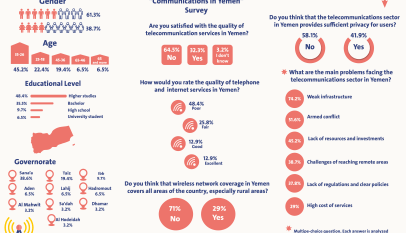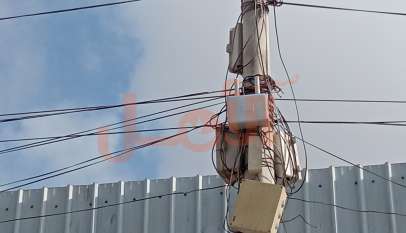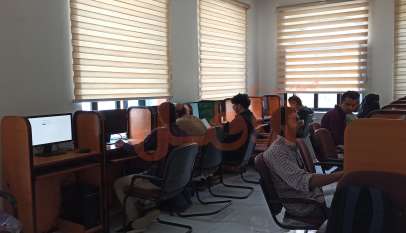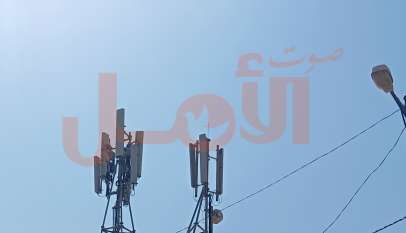A Historical Overview of the Telecommunications Sector in Yemen
Sawt Al-Amal (Voice of Hope) – Hanan Hussein
The telecommunications sector in Yemen has witnessed rapid development during the past decades, starting from its modest beginnings in the early twentieth century to what it is today, with advanced and modern communications networks covering various parts of the country. The telecommunications and information technology sector are one of the vital sectors in Yemen, as it still plays an important role in the economic and social development of the country. This sector has gone through many stages since its inception, and in this report, we will provide a glimpse of its beginnings.
Emergence of the Telecommunications Sector in Yemen
The beginning of the telecommunications sector in Yemen was with the emergence of the telegraph service in 1893, during the Ottoman Empire rule in northern Yemen at that time. It operated solely with light signals, covering short distances not exceeding a kilometer. Morse code signals were used in designated offices in Sana’a and some other cities.
Afterwards, the era of landlines began between 1956 and 1958, including approximately 800 telephone lines in northern Yemen, distributed over Sana’a, Taiz, and Hodeidah.
In the southern part, there were telegraph services, reacing a total capacity of 7,855 telephone lines in the 1960s, by the year 1967. Telecommunications services in the southern part of Yemen appeared under the supervision of the British Telegraph and Wireless Company until 1978. Later, they spread to the cities of Aden, Al-Hawtah in Lahj, Zinjibar in Abyan, Al-Mukalla, and Seiyun.
In 1978, contracts were signed with three French companies to provide 26,500 fully serviced telephone lines, including electricity, air conditioning, and microwave technology, to enhance communications in northern Yemen. Then, in late 1980, the Shu’ub Telephone Exchange was inaugurated in Sana’a, followed by the launch of an international telephone exchange and a ground station in September 1982 for international communications.
The development in the communications sector in Yemen continued until 1990, with the extension of submarine fiber optic cables between Yemen and Djibouti began. However, the ongoing conflicts in Yemen at that time caused a delay in the completion and development process. Additionally, these conflicts caused many losses in various fields and sectors, including the communications and information technology sector, which is struggling to maintain service provision.
The Ministry of Communications and Information Technology has implemented its development and improvement projects that keep pace with the continuous technological developments globally. The laying of the submarine cable was completed in 1996, and another terrestrial fiber cable was extended linking Yemen to the Gulf States. Expansion contracts were multiplied, and the total number of contracts to expand the exchanges reached 171 thousand lines in 1997 only.
Stages of the Emergence of Telecommunications in Yemen
During the period of the spread of the communications sector in Yemen and it is facing many challenges during the periods of successive conflicts, the communications sector continues its growth stages until reaching a more advanced era. This is achieved through the emergence of fiber optics in Yemen, the development of the telephone network, and contracting with new companies, such as Huawei, which supports the European system SDH (digital synchronization system) for landlines.
Several mobile phone companies also emerged, such as SabaFon and YOU (MTN – formerly Spacetel) in 2001, Yemen Mobile in 2004, and Y Telecom in 2006. Additionally, international radio and television transmission services expanded, and the TeleYemen network expanded through several different stages to provide advanced international services. According to economic reports, the total capacity of the international communications system reached 3,812 telephone channels by the year 2004, distributed over the following systems: satellites (1,414 channels), submarine cable (655 channels), and fiber optics (1,743 channels). This information is sourced from the official website of Aarif University.
Companies Operating in the Telecommunications Sector
Many companies operating in the communications sector have emerged through different stages, including public, private, and mixed companies. One such company is TeleYemen) for international communications and internet services. which is one of the first communications companies in Yemen and the Middle East. It is responsible for international communications in Yemen, adopting the international code 967 for Yemen, and constitutes a mixed sector.
Another notable company is Yemen Mobile Company, which provides mobile phone services using the CDMA2000 system. It is the only company operating the CDMA2000/1x system in Yemen. Despite its beginnings with studies and establishment with full support from the Ministry of Communications, it was later privatized. Yemen Mobile numbers start with 77 and 78, and its network code is 421-03. According to 2022 statistics, the number of subscribers exceeds more than 10 million, and it operates as a mixed sector.
SabaFon is a private sector company that provides mobile phone services using the GSM system. It was granted a license from the Yemeni Ministry of Communications, and the network code 421-01 was allocated to the company. SabaFon’s mobile numbers start with 71, and the number of its subscribers exceeded 6 million by 2021.
The company YOU, previously MTN – Spacetel, also operates in the mobile phone sector using the GSM system. It is a private company that obtained a license from the Yemeni Ministry of Communications, with the network code 421-02 allocated to it. YOU’s mobile numbers start with 73.
As for Y Telecom, it is a private sector company that provides mobile phone services using the GSM system. It was granted a license from the Yemeni Ministry of Communications, and the network code 421-04 was allocated to it. Its mobile numbers start with 70, and the number of subscribers has reached approximately 180,000.
Public Sector and Telecommunications in Yemen
There are companies operating in the field of communications and information technology in Yemen that belong to the public sector, providing various services to the Yemeni public in all Yemeni governorates. One such entity is the General Corporation for Communications and Information Technology. It provides landline and wireless telephone services, and rural communications, utilizing both analog and digital transmission systems such as microwave stations and ground stations. Additionally, there is the Geenral Institute for Communications, which aims to enhance the workforce within the ministry and qualify them in specific fields and other cultural fields in general, thereby serving the communications sector in Yemen. The leap achieved by the ministry in its work path has made the institute a destination for global companies, becoming an international hub and a center for higher education for all citizens, such as for Oracle tests.
The General Authority for Postal Savings is also a strong competitor in the field of bill payment services of all kinds, which follow the communications sector in Yemen, and works to transfer amounts and some government salaries to citizens in all Yemeni governorates.
The importance of the City of Science and Technology, which is the department responsible for the famous monthly magazine (Telecommunications Technology Magazine) and software services, comes in presenting everything new technologically to society and those interested in particular. This has helped establish it as a distinguished and important addition to the Remote Sensing Center.
While YemenNet services for software and Internet services included hosting various websites, providing Dialup, ISDN, ADSL digital subscriber line services, data messaging, and others.
Recent Developments
Experts in the field of information technology explained that mobile phone networks currently cover more than 90% of the population of Yemen, and these networks provide various services, such as voice calls, text messages, and Internet services. The service was first introduced in 1996, and the number of Internet users has increased significantly in recent years, with the global boom towards various Internet networks, which provide great opportunities for opening projects that generate large sums of money for them. The speed of the Internet has led to the spread of the use of social networking applications, such as: WhatsApp, Facebook, and other applications that provide offers for business, commerce, and entertainment as well.
Telecommunications companies currently provide internet services through various technologies, such as ADSL, WI-FI, 4G. It is expected within future plans to expand their activities to provide 5G service, according to the vision of economists.
In conclusion, we can say that the telecommunications sector in Yemen has become a promising sector for success, with great potential for growth and development, but there are many challenges and difficulties that must be overcome in order to achieve this development and advance a sector that facilitates the life of the Yemeni citizen.
74.2% of Respondents in the Survey See the Lack of Infrastructure as One of the Most Prominent Problems Facing the Telecommunications Sector in Yemen
Sawt Al-Amal (Voice of Hope) – Yomna Ahmed The telecommunications sector is one of the mo…














